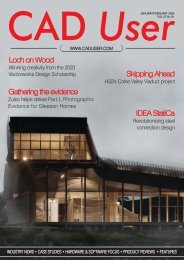Create successful ePaper yourself
Turn your PDF publications into a flip-book with our unique Google optimized e-Paper software.
INDUSTRYfocus<br />
HS2<br />
creating a real time data stream.<br />
"It's the connectivity between the<br />
physical asset in the real world and its<br />
digital twin that makes the difference,"<br />
explained Steve.<br />
DIGITAL TWINS IN ACTION<br />
Where better could we go for an example<br />
of digital twins in action in Rail<br />
Infrastructure than to HS2? The STRABAG<br />
joint venture with Skanska and Costain,<br />
HS2 has generated a lot of hot air and<br />
opposition because of its route, cost,<br />
purpose and necessity, and even the trend<br />
towards WFH has given its critics further<br />
ammunition, but I believe a couple of<br />
critical factors swing the balance in its<br />
favour. The railway system in the North of<br />
England is clogged with both passenger<br />
and freight trains, and that cannot be<br />
relieved until much of the former is<br />
transferred to a newer and faster system.<br />
The second factor is traditional. Railways<br />
transformed this country in the 19th<br />
Century (and the rest of the world in<br />
passing) and spreading the upfront cost<br />
over a century or more's practical usage is<br />
pretty good value!<br />
To explain, though, how the joint venture<br />
has successfully digitised its operation, we<br />
had Peter Ruff, head of BIM at Skanska<br />
Costain STRABAG Joint Venture and<br />
Roberto Alberola, BIM Information<br />
Manager - TYPSA UK - SCS Railways.<br />
Peter and Roberto jointly outlined the way<br />
in which the joint venture was harnessing<br />
the power of BIM to design, construct and<br />
maintain digitally the project using<br />
graphical and non-graphical information in<br />
a CDE which provided real-time access to<br />
reliable and accurate information, using<br />
4D, 5D and the 6D workflows and<br />
simulations outlined above.<br />
The stretch of HS2 that they cover is the<br />
26km section leading from central<br />
London. It includes 20km of tunnels, 6<br />
shafts, 2 portals, 5 bridges and 5Km of<br />
earthworks. The joint venture also has to<br />
consider 7 TDMs (Travel Demand<br />
Strategies). This is definitely the most<br />
complex part of the whole HS2 as it<br />
involves complex interfaces to central<br />
London and the existing infrastructure,<br />
which comprises Network Rail, London<br />
Underground and other utilities.<br />
Besides the various levels of BIM in<br />
operation, the CDE and Asset information,<br />
the joint venture manages information<br />
flows from numerous other key areas:<br />
Geospatial, in the shape of web maps and<br />
spatial analysis, Data Services, which<br />
include analytics, structures, databases<br />
and schemas and Tech Services to cover<br />
digital surveys, VR, AR and even mobile<br />
field data acquisition.<br />
Peter explained that with access to data<br />
at all levels, the JV is able to plan more<br />
effectively, and to visualise the project<br />
using tools like Synchro months, and even<br />
years, in advance, and to use the analysis<br />
to optimise the project's sequencing.<br />
Emphasising the project's aim to reduce<br />
its carbon footprint, he explained that<br />
rapid analysis of carbon emissions<br />
enabled them to optimise construction in<br />
a more sustainable manner.<br />
The 'Build' part of the project uses data<br />
collection from reality meshes, point<br />
clouds to find construction out of<br />
tolerance, and virtual and augmented<br />
reality to view the construction project in a<br />
new, more interactive setting.<br />
Overall, the digitalisation of the HS2<br />
project exemplifies its benefits. As Peter<br />
explains, "Going digital with Bentley has<br />
allowed us at SCS to realise our mission<br />
statement of creating a digital Blueprint for<br />
infrastructure projects of the future."<br />
His views were emphasised by Roberto.<br />
"The complexity of the project demanded<br />
a very high level of control of the technical<br />
outputs (models, drawings, data), so the<br />
"traditional" approach - using standardised<br />
content, trusting existing or external<br />
databases and going with software<br />
defaults - wouldn't suffice. We created a<br />
complete custom live working<br />
environment for Bentley's OpenBuildings<br />
Designer that lives in ProjectWise,<br />
ensuring that the models are built from a<br />
centralised library so that all the<br />
information is added consistently,<br />
achieving the highest data quality required<br />
to feed in all the downstream processes."<br />
The virtual Press Conference provided<br />
substantially more examples of rail<br />
projects worldwide, including details on<br />
station design and the flow of passengers<br />
using LEGION Simulator and<br />
OpenBuildings Station Designer.<br />
Developed to simulate the efficient flow of<br />
rail passengers during peak journey times<br />
and station evacuations, LEGION<br />
Simulator has also implemented social<br />
distancing modules to cope with the<br />
current demands of Covid-19. Both of<br />
these areas will be covered in greater<br />
detail in the next issue of the magazine.<br />
www.bentley.com<br />
<strong>Jul</strong>y/<strong>Aug</strong>ust <strong>2020</strong> 17

















